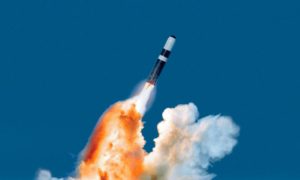British Pugwash note: Two Thirds of UK Public Opposed to “First Use” of Nuclear Weapons (PDF report here)
 The “Interim National Security Strategic Guidance” of the United States, released on 3 March 2021, states that the Biden administration will take steps to reduce the role of nuclear weapons in national security strategy, while ensuring that the U.S. strategic deterrent remains safe, secure, and effective.
The “Interim National Security Strategic Guidance” of the United States, released on 3 March 2021, states that the Biden administration will take steps to reduce the role of nuclear weapons in national security strategy, while ensuring that the U.S. strategic deterrent remains safe, secure, and effective.
In 2017, then Vice-President Joe Biden stated: “Given our non-nuclear capacities and the nature of today´s threats, it is hard to envision a plausible scenario in which the first use of nuclear weapons by the United States would be necessary or would make sense”. He proposed that “deterring, and, if necessary, retaliating against a nuclear attack should be the sole purpose of the US nuclear arsenal”.
In a Foreign Affairs article in 2020 Biden, as a presidential candidate, pledged, to work to put “sole purpose” into practice, in consultation with the U.S. military and U.S. allies”.
There seems, then, to be a possibility that the Biden administration will adopt “sole purpose” as a basic tenet of U.S. nuclear weapon policy. Speculation to that effect has been apparent this year in nuclear arms control and risk reduction circles in Washington D.C. A review of the “nuclear posture” of the United States, currently under way, would offer an appropriate context for the adoption of what would be an important nuclear risk reduction measure.
US adoption of “sole purpose” would have consequences for NATO’s nuclear weapon policy, as this currently holds open the possibility of “first use” of nuclear weapons by not ruling it out. NATO’s 2010 Strategic Concept describes the policy as follows: “Deterrence, based on an appropriate mix of nuclear and conventional capabilities, remains a core element of our overall strategy. The circumstances in which any use of nuclear weapons might have to be contemplated are extremely remote.”
This being so, British Pugwash recently commissioned a nationally-representative survey of UK public opinion in relation to “first use”.
Asked whether, if Russia were to use nuclear weapons against one or more NATO members, they would wish NATO to retaliate by using nuclear weapons against Russia, 51% of the 2093 respondents suggested that they were not opposed to the retaliatory use of nuclear weapons by answering ‘yes’. However, asked whether, in the event of Russia invading one or more of the Baltic states, without using nuclear weapons, NATO should rely exclusively on non-nuclear weapons in the ensuing military operations, 65% answered ‘yes’. And a slightly larger majority, 70%, wished NATO to refrain from using nuclear weapons in the event of such an invasion.
In effect, the survey revealed two-thirds majorities for the sole purpose of NATO’s nuclear arsenal being to retaliate against nuclear attack.
—-
Recently British Pugwash has also convened, in cooperation with German Pugwash, a meeting of defence experts to identify reasons for thinking that NATO adoption of “sole purpose” would not be a rash or foolish nuclear risk reduction measure. The exercise produced five reasons.
1 Threatening “first use” of nuclear weapons to deter non-nuclear aggression is not the only option open to NATO. Strengthening non-nuclear defensive capabilities, if necessary, and engaging in diplomacy constitute realisable alternatives.
It is not obvious that NATO lacks sufficient non-nuclear/conventional defensive capabilities to deter non-nuclear/conventional aggression on one or more NATO members. However, if military experts assess such a lack to exist, the remedy is obvious: a collective increase in investment in defensive capabilities. Such investment would surely be acceptable to European taxpayers if it were presented as reducing the risk of a non-nuclear attack on European NATO necessitating a sub-strategic nuclear exchange that could escalate into a global nuclear catastrophe.
For its part, diplomacy can aspire realistically to produce a mutual balance of NATO and Russian conventional forces in theatres where NATO fears Russian non-nuclear aggression, and at building mutual NATO/Russian confidence in the mutual absence of aggressive intentions.
2 It is questionable whether threatening “first use” of nuclear weapons is a credible deterrent. As the use of nuclear weapons would turn front-line states into wastelands, potential aggressors can reason that public opinion in those states would be strongly opposed to “first use”; and they can infer that this opposition would exercise a determining influence on the decision-making of democratic governments. A sufficiency of non-nuclear defensive capabilities would provide a far more credible deterrent.
3 “First use” doctrines are built on speculation. They suppose that the use of nuclear weapons can be limited to minimise harm to non-combatants and to avoid nuclear escalation. There is no empirical evidence for this supposition. It would be more reasonable to suppose that the consequences of a resort to nuclear weapons in the event of a non-nuclear attack on a European NATO member would be unpredictable but potentially catastrophic.
4 Given the probability that “first use” would result in the deaths of many non-combatants, it is doubtful whether “first use” would be compatible with respect for the Law of Armed Conflict. This law strikes a balance between military necessity and humanitarian considerations by providing that in combat only military objectives and objects of military value may be attacked. Military objectives are defined as members of state or non-state armed forces and persons participating directly in hostilities.
5 It would be surprising if surveys of European public opinion failed to provide grounds to believe that a large majority of European citizens opposes “first use” and sees an important distinction between retaliatory use and “first use”.
If you would like more information about the survey or would like comment from a senior member of British Pugwash, get in touch on office@britishpugwash.org
